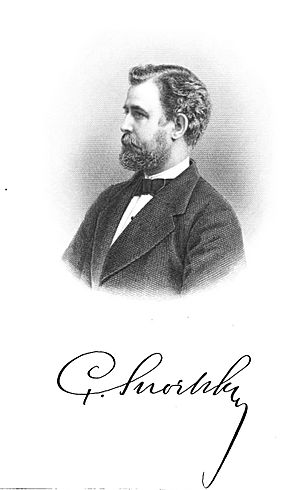Carl Snoilsky facts for kids
Carl Johan Gustaf Snoilsky (born September 8, 1841 – died May 19, 1903) was a famous Swedish poet. He was known for his realistic poetry, which means his poems often showed life as it truly was.
Biography
Carl Snoilsky was born in Stockholm, the capital of Sweden. His mother, Sigrid, was a painter, and his father, Nils, was a count and worked in the royal court.
Carl went to school in Stockholm and later studied at the University of Uppsala. He first trained to be a diplomat, which is someone who represents their country in other nations. He even worked at the Swedish Foreign Ministry, which handles Sweden's relationships with other countries.
In 1861, Carl started publishing poems under the pen name "Sven Tröst." He quickly became a popular figure in Stockholm's literary scene. In 1862, he released his first collection of poems called Orchideer ("Orchids"). He also spent time in Madrid and Paris for his diplomatic work.
It was in 1869 that Carl Snoilsky truly became famous as a poet when he published his collection Dikter under his own name. His book Sonnetter in 1871 made his reputation even stronger. For a few years, he stopped writing poetry to focus on his work at the Foreign Office and to study numismatics, which is the study or collection of coins and money.
In 1876, Carl translated some ballads by the famous German writer Johann Wolfgang von Goethe. Around this time, he also got important jobs at the Foreign Ministry. He became the head of the political department and later a deputy director. In 1878, he was chosen to be one of the eighteen members of the Swedish Academy, a group that works to improve the Swedish language and literature.
However, in 1879, Carl Snoilsky left all his jobs and moved to Florence, Italy. He married Ebba Piper there in 1880. From Florence, he continued to write. In 1881, he sent home a new book called Nya Dikter ("New Poems"). He published more collections of poems in 1883, 1887, and 1897. He also wrote a long poem called Savonarola in 1883 and Hvita frun ("The White Lady") in 1885.
One of his most important works is Svenska bilder (Swedish Pictures), published in 1886. This collection of poems focused on Swedish history and culture and is considered a classic in Sweden.
In 1891, Carl Snoilsky returned to Stockholm. He was appointed the main librarian of the Swedish Royal Library, which is a very important library. He passed away in Stockholm on May 19, 1903. His collected poems were published after his death between 1903 and 1904.
His Poetry
Carl Snoilsky had a big impact on literature in Sweden. His poems often celebrated joy, freedom, and beauty. Many people felt that his lyrics captured the excitement and energy of youth. He was also known for how delicate and musical his poems sounded.
See also
 In Spanish: Carl Snoilsky para niños
In Spanish: Carl Snoilsky para niños


